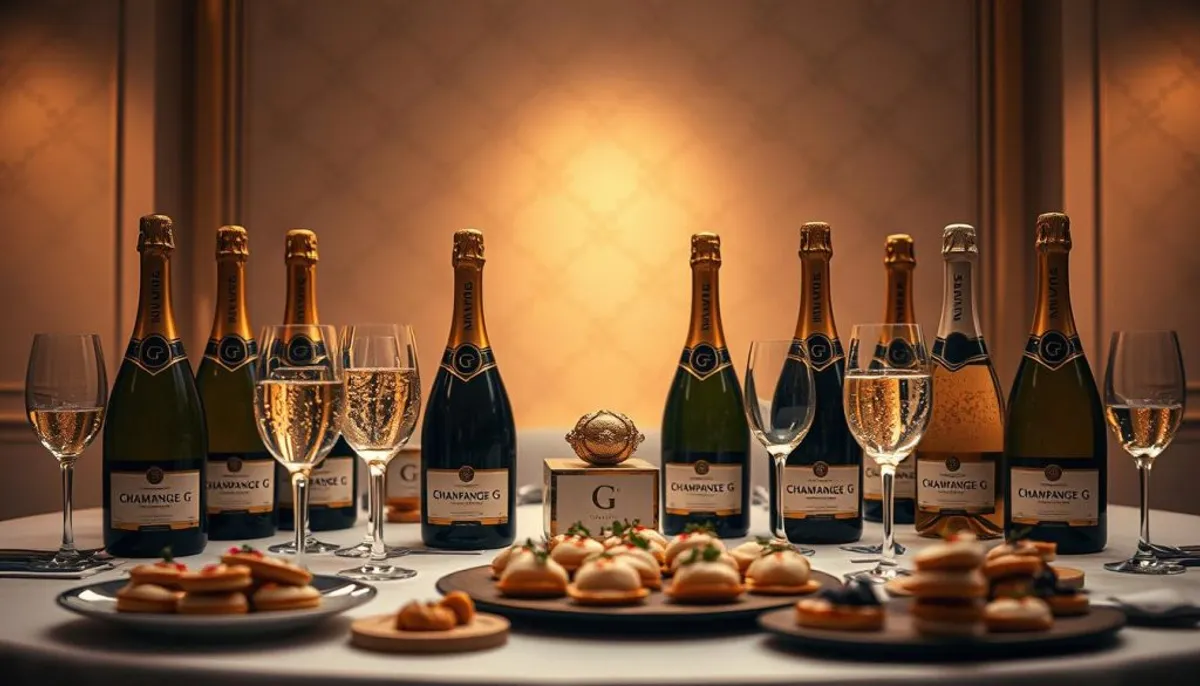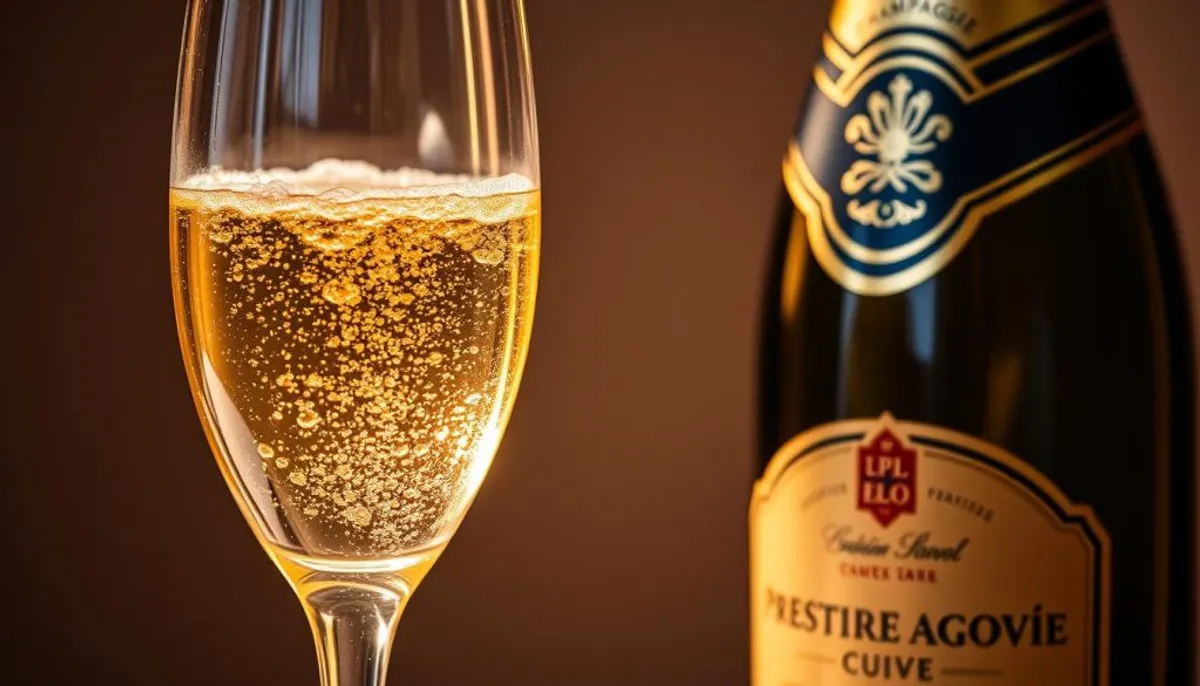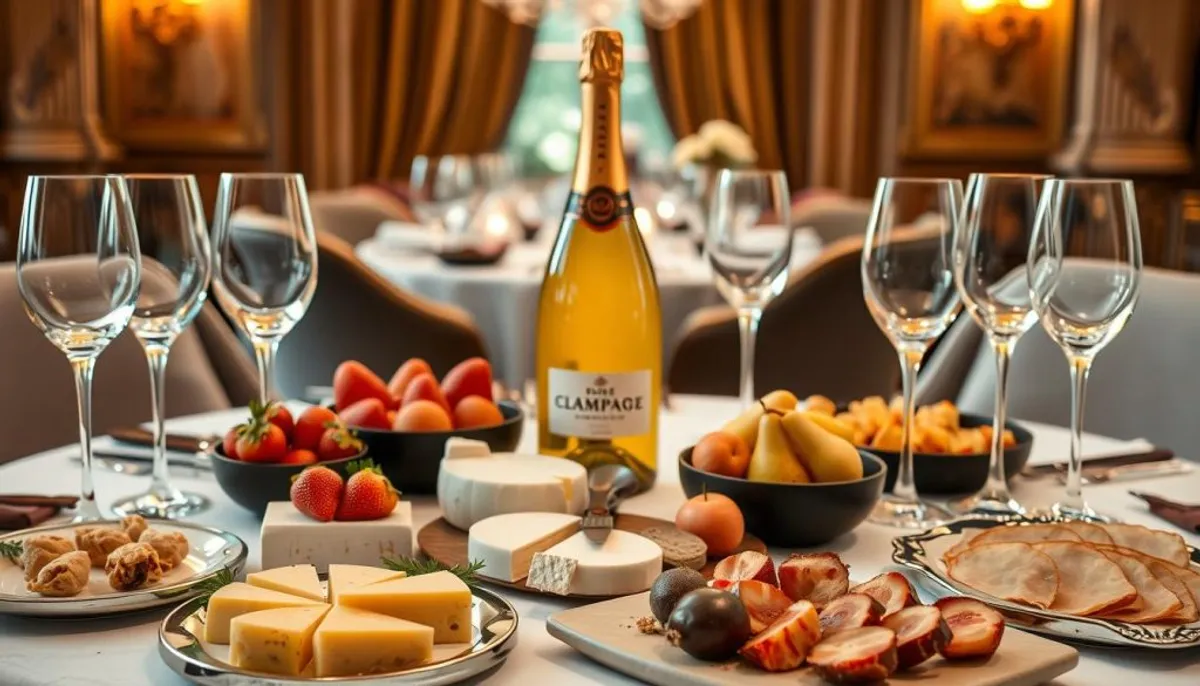Welcome to the world of Champagne G, where the essence of luxury meets the effervescence of bubbles. Our collection is a showcase of the finest sparkling wines from France’s celebrated Champagne region. With a heritage spanning centuries, Champagne G presents a taste of sophistication in every sip.
The global Champagne industry distributes approximately 300 million bottles annually. This staggering figure underscores the significance of celebrating life’s moments with a glass of fine wine. Our selection includes esteemed brands like Veuve Clicquot, which commands a substantial market share, selling 1.5 million cases each year. From budget-friendly options starting at $33 to premium cuvées exceeding $160, we cater to diverse tastes and budgets.

Whether you’re a seasoned connoisseur or new to the sparkling wine realm, Champagne G welcomes you to explore our exquisite offerings. Our collection, ready for worldwide shipping, brings the essence of French vineyards directly to your glass. Let’s pop a cork and embark on a journey through the effervescent world of Champagne G!
Key Takeaways
- Champagne G offers a wide range of sparkling wines from France’s Champagne region
- Our collection includes both affordable and premium options
- Veuve Clicquot is a top-selling brand in our lineup
- We provide worldwide shipping for our Champagne selections
- Our offerings cater to both novices and experienced Champagne enthusiasts
The Rich Heritage of French Champagne Making
The history of French wine is rich, but none as effervescent as Champagne’s. The Champagne region, located in northern France, has been cultivating grapes since the 5th century. Spanning about 86,500 acres, it is the birthplace of the world’s most celebrated sparkling wine.
Origins in the Champagne Region
The Champagne region’s unique terroir, characterized by chalky soil, is crucial for its wines’ distinct flavor. Early vineyards, such as the 25-acre plot owned by the Abbey of Hautvillers in 1661, set the stage for a global phenomenon.
Historical Development of Méthode Champenoise
The méthode champenoise, Champagne’s traditional making method, evolved over centuries. By the late 1600s, winemakers were perfecting the art of creating bubbles intentionally. Dom Pérignon, a Benedictine monk, introduced thicker glass bottles and emphasized careful pruning techniques, making significant contributions.
Evolution of Traditional Houses
As Champagne’s popularity soared, so did its production. By 1900, annual shipments reached 30 million bottles. Despite challenges like World War I’s destruction of vineyards, the industry persevered. Today, over 200 million bottles are produced annually, with sales quadrupling since 1950.
| Year | Milestone |
|---|---|
| 5th century | First recorded vineyard in Champagne |
| 1662 | Documentation of adding sugar to create bubbles |
| 1876 | Creation of first prestige Champagne, Cristal |
| 1936 | Establishment of Appellation d’Origine Contrôlée |
Understanding Premium Champagne G Selection
Champagne G is renowned for its unparalleled quality and distinctive character. Our collection features the finest grapes sourced from the Champagne region’s elite vineyards. Each bottle embodies the essence of its terroir, delivering a luxurious experience accessible globally.
Exclusive Grape Varieties
Our champagnes are crafted from three primary grape varieties: Chardonnay, Pinot Noir, and Pinot Meunier. These grapes are the foundation of our blends, each contributing unique flavors and aromas. Chardonnay imparts elegance and finesse, while Pinot Noir adds body and structure. Pinot Meunier, on the other hand, brings fruity notes and freshness.
Terroir Influence
The terroir of Champagne profoundly influences our wines. Chalky soils in the Côte des Blancs yield crisp Chardonnays. The Montagne de Reims, with its chalky terrain, produces robust Pinot Noirs. In the Vallée de la Marne, a blend of chalk, limestone, and marl nurtures vibrant Pinot Meuniers. This variety of soils and microclimates in our vineyards results in complex, layered champagnes.
Production Methods
We adhere to the traditional Méthode Champenoise, involving two fermentation stages. The first fermentation occurs in tanks, followed by a second in bottles. This meticulous process, combined with a minimum aging of 15 months for non-vintage and 3 years for vintage champagnes, ensures depth and character in every glass.
| Grape Variety | Primary Region | Soil Type | Flavor Profile |
|---|---|---|---|
| Chardonnay | Côte des Blancs | Pure chalk | Elegant, crisp, citrusy |
| Pinot Noir | Montagne de Reims | Chalky | Full-bodied, red fruit notes |
| Pinot Meunier | Vallée de la Marne | Chalk, limestone, marl | Fruity, fresh, round |
Our premium Champagne G selection reflects the artistry of our winemakers and the generosity of our land. Spanning 34,000 hectares, our vineyards produce a million bottles daily. We are eager to share our passion with champagne enthusiasts worldwide, especially during the exhilarating formula 1 celebrations.
Distinctive Characteristics of Prestige Cuvées

Prestige cuvées stand as the zenith of champagne artistry. These elite wines are crafted exclusively in exceptional vintage years. Producers meticulously select the finest grapes from their most esteemed vineyards. The tradition of prestige cuvées began in 1876, when Louis Roederer created Cristal for Tsar Alexander II, establishing a benchmark for luxury champagnes.
The hallmark of prestige cuvées is their extended aging period. Unlike standard champagnes, which age for 15 months, these wines mature for at least 8 years. Some, such as Charles Heidsieck’s Blanc des Milleniares, undergo an astonishing 17 years of aging. This prolonged maturation enhances their complexity and richness of flavor.
Prestige cuvées are distinguished by several unique traits:
- Ethereal structure and finesse
- Complex flavor profiles with salty and umami notes
- Creamy, nutty finishes that linger on the palate
- Pronounced acidity balanced by rich, layered flavors
Notable prestige cuvées include Moët & Chandon’s Dom Perignon, Veuve Clicquot’s La Grande Dame, and Taittinger’s Comtes de Champagne. These wines are often encased in gold foil to shield them from light, preserving their delicate essence.
Whether marking a special event or aiming for the pinnacle of champagne indulgence, prestige cuvées offer unmatched quality and elegance. Their rarity, meticulous craftsmanship, and extraordinary taste make them invaluable assets for any connoisseur’s collection.
The Art of Champagne Tasting and Storage
Mastering the art of champagne tasting and storage elevates your sparkling wine experience. Whether you’re savoring a vintage bottle or a fresh non-vintage blend, proper care ensures each sip is perfect.
Proper Temperature Control
Temperature plays a crucial role in champagne enjoyment. Non-vintage champagnes shine at 8-10°C (47-50°F), while vintage selections prefer a slightly cooler 9-12°C. For the best practices for storing champagne, keeping bottles at 55°F or below preserves their quality.
Glassware Selection
The right glass enhances your tasting experience. Flutes preserve bubbles and encourage crisp effervescence. Tulip glasses allow aromas to develop fully. For aged vintage champagnes, wide tulips collect complex flavors beautifully.
Aging Potential
Champagne’s aging potential varies. Non-vintage blends are typically fresh and vibrant, best enjoyed within a few years. Vintage champagnes can develop complexity over decades, rewarding patient collectors with nuanced flavors.
| Champagne Type | Sugar Content (g/L) | Flavor Profile |
|---|---|---|
| Brut | 0-12 | Dry, most common |
| Extra Dry | 12-17 | Slightly sweet |
| Demi-Sec | 32-50 | Noticeably sweet |
| Doux | 50+ | Very sweet |
Remember, proper storage is key. Keep bottles on their side in a cool, dark place. When it’s time to serve, ensure each bottle is chilled to perfection. For personalized advice on building your champagne collection, visit https://champagne-export.com and request a quote today.
Vintage vs Non-Vintage Selections
Champagne G presents a wide array of choices, encompassing both vintage and non-vintage champagnes. Non-vintage champagnes, the majority, are crafted from a blend of grapes from various years. This blend typically includes 50% to 80% of a single base year, complemented by reserve wines from other years.
Vintage champagnes, by contrast, are made from grapes harvested in a single, specific year. They are characterized by higher acidity and a more pronounced structure, which enhances their aging potential. Connoisseurs often view vintage champagnes as superior, due to the meticulous selection of grapes during exceptional harvests.
| Characteristic | Non-Vintage Champagne G | Vintage Champagne G |
|---|---|---|
| Production frequency | Every year | Only in exceptional years |
| Grape source | Multiple years | Single year |
| Consistency | More consistent | Varies by vintage |
| Aging potential | Shorter | Longer |
| Price point | Generally lower | Usually higher |
The art of blending is pivotal in non-vintage production. Skilled cellar masters meticulously combine wines from different years to achieve a harmonious blend. Some producers employ complex reserve systems, incorporating oak to deepen and enrich the flavor profile. This meticulous process ensures a consistent house style across all vintages.
Whether you lean towards the reliability of non-vintage or the distinctiveness of vintage champagnes, Champagne G has something for every taste. Each bottle is a testament to the art of blending, combining tradition with innovation. It is designed to enhance any celebration, including high-end events.
Food Pairing with Premium Champagnes
Champagne, the epitome of french wine, presents a myriad of pairing options. Its effervescence and intricate flavors elevate a broad spectrum of culinary creations. We will examine traditional pairings, innovative matches, and recommendations for special occasions.
Classic Pairings
Timeless pairings for Champagne include oysters, caviar, and refined seafood. The sharp acidity of Brut Champagne effectively counterbalances rich flavors. Blanc de Blancs Champagne, with its citrusy undertones, beautifully complements light fish dishes.
Contemporary Gastronomy Matches
Modern culinary trends introduce novel pairing possibilities for Champagne. Rosé Champagne, featuring strawberry notes, pairs exquisitely with sushi. Blanc de Noirs, crafted from red grapes, pairs well with heartier dishes such as roasted poultry or mild cheeses.

Special Occasion Recommendations
For grand celebrations, consider these pairings:
- Wedding toast: Brut Champagne with strawberries
- Anniversary dinner: Vintage Champagne with lobster
- New Year’s Eve: Demi-Sec Champagne with fruit-based desserts
| Champagne Style | Characteristics | Food Pairing |
|---|---|---|
| Brut | Dry, small amount of sugar | Versatile, pairs with most dishes |
| Blanc de Blancs | Very dry, citrusy, floral notes | Seafood, light appetizers |
| Rosé | Dry, hints of red fruits | Sushi, light meats |
| Demi-Sec | Semi-sweet | Desserts, fruit-based dishes |
The essence of perfect Champagne pairing lies in achieving balance. Allow the effervescence of this exquisite sparkling wine to enhance your meal’s flavors, crafting memorable dining experiences.
Investment Value and Collection Potential
Champagne G and vintage selections have become coveted investment choices, particularly with the rise in popularity of music downloads related to Champagne culture. The Liv-Ex Champagne 50 Index has outperformed gold, the FTSE, and the S&P 500 in recent years. This growth underscores the increasing valuation of champagne as a valuable asset.
Vintage champagnes, in particular, exhibit remarkable appreciation. For instance, the 2012 Louis Roederer Cristal saw an 80.1% price increase from April 2021 to February 2023. The 2006 Krug Vintage Brut also climbed 57% over five years, making it a part of the 250 cuvées selection that showcases the best in champagne.
Rarity significantly influences champagne’s investment value. Vintage champagne is produced only in exceptional years, typically three times a decade. This scarcity drives up prices, notably for prestigious houses like Champagne G.
| Champagne | Price Increase | Time Period |
|---|---|---|
| 2012 Salon Le Mesnil | 232% | Jan-Sep 2022 |
| 2008 Jacques Selosse | 100%+ | Since release |
| 2012 Cedric Bouchard Les Ursules | 332% | 5 years |
For those considering champagne investment, starting with reputable houses and notable vintages is advisable. While the investment potential is exciting, champagne’s primary purpose remains enjoyment. To explore your options, request a personalized quote at https://champagne-export.com.
Global Export and Availability
The champagne region’s exports have recently encountered significant hurdles. Last year, shipments plummeted by nearly 10%, with sales plummeting over 15% in the first half of 2024. Despite these setbacks, the region’s vineyards persist in crafting exceptional wines, highly coveted globally.
International Markets
French champagne’s allure extends beyond borders. In 2024, a total of 271.4 million bottles were shipped. The domestic market absorbed 118.2 million bottles, while exports reached 153.2 million bottles. France, China, and India lead the list of top exporters, underscoring the beverage’s universal appeal.
Authentication Process
Authenticity is paramount in the champagne trade. With over 6,182 exporters and 6,547 buyers involved, stringent authentication processes are imperative. These measures safeguard the champagne region’s reputation, ensuring genuine products reach consumers.
Shipping Standards
Maintaining high-quality shipping standards is essential for preserving champagne’s fragility. Despite climate change’s impact on harvests, the industry adheres to strict shipping protocols. This dedication is evident in the export market’s growth, which surged by 11% from March 2023 to February 2024.
| Metric | Value |
|---|---|
| Total Export Shipments (Mar 2023 – Feb 2024) | 40,322 |
| Number of Exporters | 6,182 |
| Number of Buyers | 6,547 |
| Export Growth Rate | 11% |
Explore the finest selections from the champagne region’s vineyards, poised for global export. Secure your personalized quote today at https://champagne-export.com.
Conclusion
Our exploration of Champagne G reveals its significance beyond mere celebration. With 3,829 five-star reviews, it’s clear that both aficionados and casual enthusiasts value its craftsmanship. This appreciation underscores the depth and quality of each bottle.
The Champagne region’s rich heritage and the subtleties of premium selections have been highlighted. We’ve delved into the artistry behind every sip. Notably, Champagne G is made from Chardonnay, Pinot Noir, and Pinot Meunier grapes. These varieties blend to create the complex flavors that delight the palate.
When enjoying Champagne G, the choice of glassware is crucial. Flutes, with their tall, narrow design, better preserve bubbles than coupes. This distinction is not merely about appearance. It impacts the duration of your Champagne G’s effervescence, ensuring a longer, more enjoyable experience.
Are you prepared to explore the world of Champagne G? Visit https://champagne-export.com to access our top selections, available for export globally. Whether you prefer Brut or Doux, there’s a Champagne G tailored for you. Here’s to the delight of French wine and the magic Champagne G adds to life’s celebrations!
RelatedRelated articles



